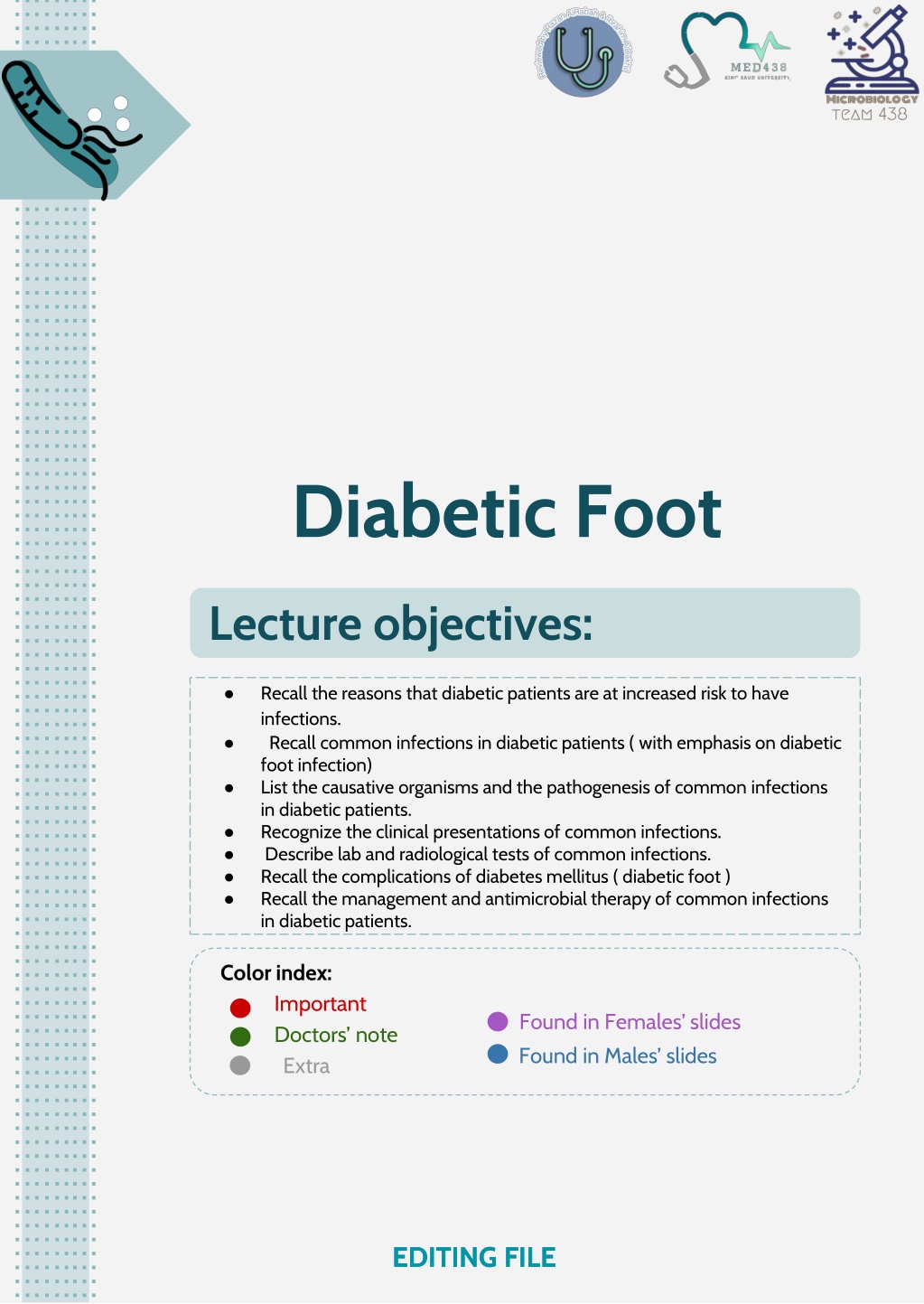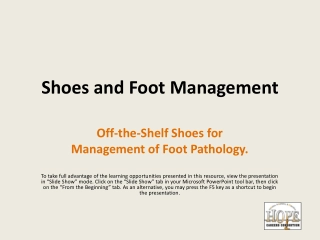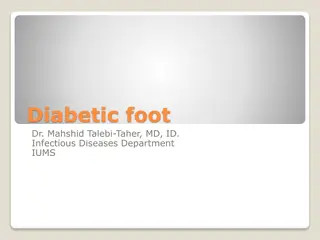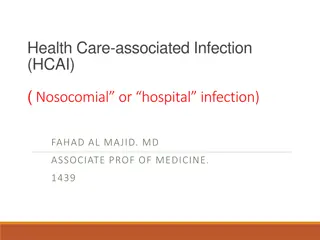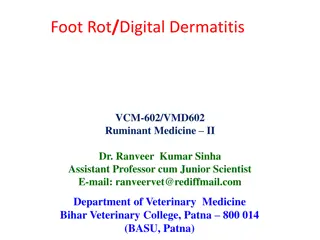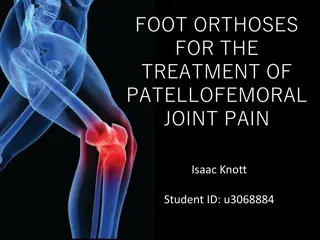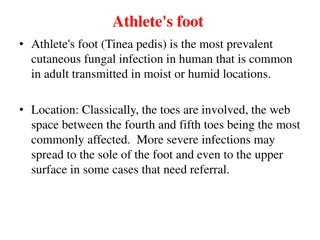Understanding Diabetic Foot Infections and Associated Risks
Diabetic patients are prone to infections, significantly impacting morbidity and mortality rates. Increased infection risk is due to both host-related and organism-related factors. Common infections in diabetic patients include skin and soft tissue infections, diabetic foot infections, respiratory tract infections, genitourinary infections, periodontal infections, and abdominal infections. Recognizing the causative organisms, clinical presentations, complications, and management strategies is crucial in providing optimal care for diabetic individuals.
Download Presentation

Please find below an Image/Link to download the presentation.
The content on the website is provided AS IS for your information and personal use only. It may not be sold, licensed, or shared on other websites without obtaining consent from the author. Download presentation by click this link. If you encounter any issues during the download, it is possible that the publisher has removed the file from their server.
E N D
Presentation Transcript
Diabetic Foot Lecture objectives: Recall the reasons that diabetic patients are at increased risk to have infections. Recall common infections in diabetic patients ( with emphasis on diabetic foot infection) List the causative organisms and the pathogenesis of common infections in diabetic patients. Recognize the clinical presentations of common infections. Describe lab and radiological tests of common infections. Recall the complications of diabetes mellitus ( diabetic foot ) Recall the management and antimicrobial therapy of common infections in diabetic patients. Color index: Important Doctors note Extra Found in Females slides Found in Males slides EDITING FILE EDITING FILE
introduction 1 Introduction Diabetic patients are predisposed to infections. Nearly half of all diabetic patients had at least one hospitalization or outpatient visit for infections compared to non-diabetic patients. Infections may increase the morbidity and mortality in diabetic patients. Why diabetic patients are at increased risk to have infections ? Because of Host related factors & Organisms related factors Organisms Specific Factors1 Organisms Specific Factors Glucose inducible proteins promote adhesion of C. albicans to buccal2or vaginal epithelium which in turn, impairs phagocytosis, giving the organism advantage over the host. Candida albicans Ketoacidosis allow Rhizopus spp. which cause Mucormycosis (Zygomycosis) to thrive in high glucose acidic conditions . Rhizopus spp. 1. 2. Any organisms even the low pathogenic, cause infections in diabetic patients. Causing oral thrush
introduction 2 Host Related Factors Host Related Factors Sensory peripheral neuropathy Minor local trauma may result in skin ulcers, which leads to diabetic foot infections Associated with postoperative hyperglycemia which is related to deleterious effect on chemotaxis, phagocytosis and adherence of granulocytes Surgical site infections Diabetic patients may develop urinary retention and stasis that in turn, predisposes to develop urinary tract infections. Autonomic neuropathy Hyperglycemia1and metabolic derangements In diabetic patient may facilitate infection. Such as : 1- Depressed Neutrophil function 2- Affected adherence to the endothelium. 3- Affected chemotaxis and phagocytosis 4- Compromised bactericidal activity. 5- Depressed cell mediated immunity Immune defects in diabetes Diabetics on insulin have asymptomatic nasal and skin colonization with S. aureus particularly MRSA Colonization predisposes to skin infection and transient bacteremia which may result in distal sites infection such as damaged muscle. In type- 2 diabetes; Mucosal colonization with C. albicans is common. Vulvovaginitis caused by Non-albicans Candida spp. is common in patients with poor glycemic control Increased skin and mucosal colonization Results in local tissue ischemia that enhances the growth of microaerophilic and anaerobic organisms while depressing the O2 dependent bactericidal functions of leukocytes. There may be also impairment of the local inflammatory response and absorption of antibiotics Vascular insufficiency 1. Uncontrolled diabetes have even higher risk of infections.
Infections in diabetic patients 3 Common infections in diabetic patients Skin and soft tissue & diabetic foot infections Upper & lower respiratory tract infections Genitourinary infections Periodontal infections Abdominal infections Upper respiratory tract infections 2- Rhinocerebral Mucormycosis 1- Invasive (malignant) otitis externa 1- Invasive ( malignant) otitis externa General info. : Uncommon but potentially life threatening. Cause: involves P.aeruginosa. Pathogenesis: Slowly invades from the external canal into adjacent soft tissues, mastoid and temporal bone and eventually spreads across the base of the skull. Signs/Symptoms: Patient presents with severe pain, otorrhoea, and hearing loss. Intense cellulitis and oedema of the ear canal. Diagnosis: CT scan and MRI studies to define the extent of bone destruction Treatment: Surgical debridement & IV anti-Pseudomonas1antibiotics. Antipseudomonal antibiotics: CAMPFIRE Carbapenems, Aminoglycosides(e.g. gentamicin), Monobactams, Polymyxins(e.g. Polymyxin B, Colistin), Fluoroquinolones(e.g. Ciprofloxacin, levofloxacin), ThIRd generation cephalosporins(e.g. Ceftazidime, cefepime), Extended-spectrum penicillins(e.g. Piperacillin, Ticarcillin) 1. (EXTRA)
Infections in diabetic patients 4 2- Rhinocerebral Mucormycosis General info. : A life threatening fungal infection Cause: (Mucormycosis) Rhizopus3, Absidia and Mucor species Signs and Symptoms: facial or ocular pain and nasal stuffiness, generalized malaise and fever. May be intranasal black eschars or necrotic turbinate. Diagnosis: Biopsy of the necrotic tissue . Direct smear examination for hyphae (Non-septate hyphae). Treatment: Surgical debridement and prolonged IV therapy with Amphotericin B1. Lower respiratory tract infections: - Pneumonia and Influenza Diabetic patients are 4 times more likely to die from pneumonia or influenza than non-diabetic patients. Common organisms : Gram positive Gram negative Others S.aureus Enterobacteriaceae Influenza virus Mycobacterium tuberculosis S.pneumoniae Legionella Routine pneumococcal and influenza vaccination recommended2. 1. 2. 3. Broad spectrum antifungal. Due to the high risk diabetic patients must take vaccination. Q: diabetic patient with ketoacidosis presented with a nasal mass (Mucormycosis) Rhizopus
Infections in diabetic patients 5 Genitourinary infections 1- Cystitis: (more common in women) Same as non-diabetics, incomplete bladder emptying and high incidence of unsuspected upper UTI. Bacteria: Gram negative rods(e.g. E.coli) or Group B Streptococcus (S.agalactiae) Fungi: Candida albicans may be involved. Symptoms: Pain above the pubic region 2- Bilateral Pyelonephritis: Diabetes predisposes to a more severe infection of the upper urinary tract. Emphysematous Pyelonephritis exclusively an infection of diabetics (60%) and carries grave prognosis ( 30% fatal). Most common caustive organism: E.coli Diagnosis: Management: supportive & IV antibiotics, nephrectomy may be needed. 3- Vulvovaginitis: flank mass & crepitus & High fever CT scan shows gas in the renal tissues. As mentioned earlier. Abdominal infections - Severe fulminating Cholecystitis Common causes: Enteric Gram negative bacteria and anaerobes Gall stone or peritonitis may be present. Gas gangrene and perforation may occur. Management: Cholecystectomy and broad spectrum antibiotics.
Infections in diabetic patients 6 Skin and soft tissue infections Risk factors in diabetic patients: Sensory neuropathy: no pain perception1. Atherosclerotic vascular disease Hyperglycemia: >250 mg/ dl History of cellulitis, peripheral vascular diseases, tinea infection2, and dry skin. Organisms Group A Streptococcus (S. pyogenes) and S. aureus CA-MRSA ( community acquired -MRSA) causes (77%) of skin and soft tissue infections - Necrotizing fasciitis A deep-seated ,life threatening infection of subcutaneous tissue with progressive destruction of fascia, fat and muscles. Organisms: 10% associated with GAS ,with or without S.aureus, anaerobes may be involved. Clinical features 1-Very severe pain of proportion of skin and anesthesia of overlying skin. 2-Violaceous discoloration of skin that evolves into vesicles and bullae. 3-Crepitus. 4-Soft tissue gas seen in radiograph or CT scan. Management: Aggressive surgical debridement & IV antibiotics. 1. 2. The patient is not aware of the trauma. Tinea infections are superficial fungal infections caused by three species of fungi collectively known as dermatophytes.
Diabetic foot infections 7 General info. The most common and most important soft tissue infection in diabetic patient is diabetic foot infection, why ? because it is related to peripheral neuropathy and compromised microvascular circulation which limits the access of phagocytic cells to the infected area and poor concentration of antibiotics in the affected area. Complicated by chronic osteomyelitis, gas gangrene, amputation and death. The spectrum of foot infection ranges from superficial cellulitis1to chronic osteomyelitis2. Combined infection involving bone and soft tissue may occur Infection may involve the skin, soft tissues, bone ,or all. Diabetic neuropathy may lead to incidental trauma that goes unrecognized. Sinus tract may be present. Pathophysiology trauma compromises local blood supply predisposing foot to infection. a microvascular disease limits blood supply to the superficial and deep structures Pressure from ill fitting shoes Organisms involved in diabetic foot infections Beta-hemolytic streptococci ( group A,B Streptococcus ), S. aureus, Entertobacteriacae ( E. coli, Klebsiella, Proteus spp.) in chronic ulcers. Cellulitis3 Macerated ulcer or nail injury (sinus) P. aeruginosa . Deep soft tissue infections (necrotizing fasciitis, or myositis). GAS & gas producing gram positive bacilli(Clostridium perfringens). GAS and Group B Streptococcus, S. aureus, Enterobacteriacae (E.coli ,Proteus mirabilis , K.pneumoniae.) & Bacteroides fragilis Chronic osteomyelitis 1. 2. 3. Involving the dermis and epidermis. Bones + soft tissue Superficial Infection
Diabetic foot infections 8 Cellulitis tender, erythematous non-raised skin lesion on the lower limb, may be accompanied with lymphangitis which suggests GAS. Bullae suggests S. aureus ,occasionally GAS. Erythemaous non raised skin lesion Deep skin and soft tissue infections Bullous (raised) lesion patient acutely ill, with painful induration of the limb especially the thigh. Foot may be involved Foul discharge suggest anaerobes1 Deep skin infection involoving the foot Osteomyelitis Acute osteomyelitis: pain at the involved bone, fever and adenopathy (lymphadenopathy) Chronic osteomyelitis: fever foul discharge There may be pain No lymphangitis Deep penetrating ulcer and sinuses on the plantar surface of the foot. Factors that increases the development of osteomyelitis: Grossly visible bone or ability to probe to bone ulcer size >2x2 cm ulcer depth > 3mm ulcer duration longer than 1-2 wks ESR >70 mm/hr. 1. E.g. Bacteroides
Diabetic foot infections 9 Diagnosis Thorough examination to evaluate the patient s vascular and neurological status. Radiological examination including doppler ultrasonography, transcutaneous oxymetry, MR angiography. CT scan ,MRI and gallium scan for soft tissue and bone evaluation. Exploration of ulcer to determine its depth and the presence of sinus tract. Deep specimens1(tissues) for culture and susceptibility testing. Management & treatment Control blood sugar and hydration2 Evaluation of neuropathy and vasculopathy Mild cases Moderate to severe cases Surgical debridement of necrotic tissues and use of antibiotics according to the causative bacteria eg. Cloxacillin3, Cephalexin3, Clindamycin4, TMP-SMX4(for CA-MRSA), Quinolones5, Amoxacillin-clavulunic acid5. Places the foot at risk of amputation. Needs hospitalization,IV antibiotics and surgical intervention as needed Prevention Is the cornerstone of diabetic foot care. It is multidisciplinary including family physician, social worker, home care nurse and specialist. Patient education about the control and complication of diabetes. Blood sugar should be controlled promptly ( shift to insulin if oral hypoglycemic agents were not effective),weight reduction, a diet low in fat and cholesterol. Proper foot care, using protective footwear and pressure reduction. Self and family member examination of foot. 1. 2. 3. 4. 5. Not superficial tissues, due to the presence of normal flora. First thing first, management is difficult with uncontrolled blood glucose. Used for MSSA Used for MRSA Used for gram negative bacteria
10 Extra Gram +ve -Cocci in clusters -Catalase: + -Coagulase : + -yellow colonies on blood agar -DNAse +ve S.aureus -Cocci in chains -Catalase: - -Coagulase : - -? ? hemolytic - Bacitracin sensitive strept. pyogenes (group A) -Cocci in chains -Catalase: - -Coagulase : - - ? ? hemolytic - Bacitracin resistant strept. agalactiae (group B ) -Diplococci -Catalase: - -Coagulase : - -? ? hemolytic -Bile soluble -Optochin sensitive strept. pneumoniae -Spore forming rods -Double zone of hemolysis -Transmission: foodborne and traumatic implantation Clostridium perfringens Gram -ve -Oxidase : - -Catalase : + -Ferment glucose Enterobacteriaceae -Gram stains poorly, use silver stain -Grow on charcoal yeast extract medium -Transmission: aerosols from environmental water source habitat ( air conditioning systems) , no person-to-person transmission Legionella - bacilli - non-lactose fermenter - oxidase: + Pseudo. aeruginosa -Reservoir: predominant anaerobe in the human colon -Transmission: endogenous from bowel defect Bacteroides fragilis
11 Extra
Explanation: Q1: Pyelonephritis (E.coli is the most common) Q2: Osteomyelitis (S.aureus is the most common) Q3: Mucormycosis due to rhizopus Q4: Necrotizing fasciitis is commonly caused by GAS Quiz MCQ: Answers: Q1:A | Q2:D | Q3:B | Q4:A Q1: A 28-year-old woman with a history of asthma & diabetes presents to the emergency department with a temperature of 38.2 C (100.8 F) and complains of shaking chills and pain on her right side, which she locates by pointing to the area above her right iliac crest. She notes that she has never had this occur before. During the examination, there is tenderness to percussion at the junction of the lower ribs and the thoracic vertebrae. Urinalysis reveals WBC casts. What is the organism most likely causing her condition? (A) Escherichia coli (B) Klebsiella pneumoniae (C) Proteus mirabilis (D) Staphylococcus saprophyticus Q2: A 35 -year-old diabetic patient sustains a deep puncture wound in his left heel while playing football. Four days later, his son brings him to the emergency department because he has become lethargic and has developed shaking chills. He refuses to bear weight on his left foot. The patient s temperature is 39.7 C (103.4 F). Physical examination shows a warm, swollen, and extremely tender area around the puncture wound. A specimen through uninfected tissue is obtained via percutaneous needle biopsy. A Gram stain of this sample is most likely to show which of the following? (A) Acid-fast bacilli (B) Catalase-negative, gram-positive cocci in chains (C) Coagulase-negative, gram-positive cocci in clusters (D) Coagulase-positive, gram-positive cocci in clusters Q3: A physician is caring for a hospitalized 31-year-old man with long-standing, poorly controlled type 1 diabetes mellitus. He is blind and has peripheral neuropathy with sensory loss in both feet, and his most recent hemoglobin A1c level was 13.9%. He recently presented with altered mental status, polyuria, and polydipsia. At that time, his serum glucose level was 475 mg/dL, arterial blood pH was 6.96, and his anion gap was 27. Since then his acidosis has resolved with appropriate treatment, and fingerstick blood glucose levels have normalized. However, he has persistent nasal discharge; paranasal sinus tenderness; black necrotic eschar on his face; and new onset of periorbital edema, proptosis, facial numbness, and obtundation. Which of the following is most likely cause of this condition? (A) Escherichia coli (B) Rhizopus (C) Staphylococcus Aureus (D) GAS Q4: Recently, there have been sensational media reports of patients infected with invasive, flesh-eating bacteria that spread rapidly through the tissues. This necrotizing fasciitis is usually caused by: (A) Group A streptococci (B) Micrococcus (C) Bacillus cereus (D) Clostridium tetani SAQ: CASE: A 55-year-old woman presents to the emergency department with confusion and lethargy. On physical examination she is found to be tachypneic and tachycardic, and her breath smells somewhat like nail polish remover. A review of her electronic medical record reveals that she was diagnosed with type 1 DM at 12 years of age. She is admitted to the hospital and treated for DKA, and her symptoms begin to improve. However, 4 days after admission she develops fever, mucoid nasal discharge, and periorbital swelling. While cultures are pending, she is treated with empiric abx but fails to improve. Q1: What is the most likely diagnosis? A: Mucormycosis Q2: What is the most likely causative agent? A: Rhizopus Q3: What is the main risk factor for this condition? A: Diabetic ketoacidosis. Q4: How to confirm diagnosis? A: Biopsy of necrotic tissue and direct smear examination for hyphae. Q5: How to treat? A: 1- Surgical debridement 2- Prolonged IV Amphotericin B
Members board Team Leaders: Abdulaziz Alshoumar Ghada Alsadhan Team sub-leader: Mohammed Alhumud This lecture was done by: Abdulaziz Alshoumar Abdulrahman Alsayed Alwaleed Alzunaidi Tariq Aloqail Naif Alhusaini Mashal abaalkhail Razan Alrabah
